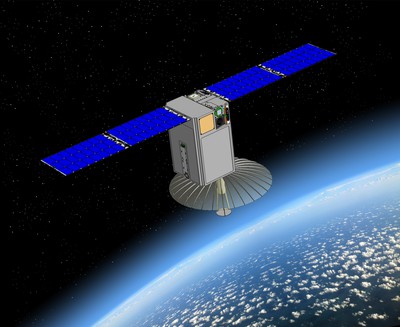Pos:
Home KnowledgeTechnologySatellite Giant company Thinks Power Amplifiers Are Better With DiamondAkash Systems opened for business late 2016, selling unusual semiconductors layered onto slabs of synthetic diamond. But the story behind the technology goes back Twenty years ago, when Felix Ejeckam, Akash’s co-founder and chief executive, started seeking out ways to make gallium nitride more efficient for radar and communications.
In 2003, Ejeckam started Group4 Labs to improve how gallium
nitride tolerates heat, which limited its already high power output. It
worked on growing the semiconductor on silicon wafers, which it
scoured off and replaced with synthetic diamond. The substrate
exhibits the highest thermal conductivity of any material, whisking
away heat almost instantly when placed close to devices.
Using the technology, Group4 made power amplifiers that handled higher operating temperatures than other types of GaN. Over the next decade, the company shrunk the space between diamond and the GaN layers to tens of nanometers, giving them three times the power density of gallium nitride layered on silicon carbide in certain tests.
In 2013, Ejeckam agreed to an acquisition by Element Six, the
manufacturing arm of diamond giant De Beers, which fabricates
synthetic diamond for industrial applications. But last year he
partnered with Ty Mitchell, a former executive at Cree, and bought
several of the original patents. Akash was born soon after.
Akash — which means sky in Sanskrit — only kept the patents related
to satellite communications, betting that its devices would thrive in
the growing commercial space market for communications and
surveillance. The industry is moving toward smaller and inexpensive
satellites sometimes called Cubesats.
“If the amplifier is inefficient, it means that lots of heat will be
dissipated in the system, causing all sorts of problems with cost and
lifetime,” Ejeckam said in a recent phone interview. “Any kind of
benefit you can offer the amplifier shows up in the application,” he
added.
Akash’s selling point is that its power amplifiers are cool enough to
generate lots of power, enabling faster downloads and greater
throughput for satellite communications. Because of that, satellite
companies can use fewer amplifiers and smaller cooling systems.
That translates into more compact satellites and lower launch costs.
The result is more powerful Cubesats without having to make them
much larger than a loaf of bread. With the explosion of the
commercial space industry, it sounds like a compelling pitch: Earth
observation start-up Planet has launched 180 Cubesats into orbit,
while Space X is aiming to launch 7,518 small communications
satellites to provide internet coverage in the V-band.
The heat generated by GaN power amplifiers collects in microscopic
hotspots, causing current leakage. When placed close enough to the
transistors, diamond substrates can remove the heat. That gives
devices longer life spans without increasing power or temperature
levels, or higher power and frequencies levels without adding heat.
Ejeckam said that the 10-person company already has customers in
the satellite industry, but that it ultimately has grander ambitions. It
wants to start making Cubestas by 2019, using its power amplifiers
for communications up to one terabit per second and earth imaging
with centimeter-level accuracy. Further out, it plans to operate a fleet
of small communications satellites by 2021.
Kris Kong, Akash’s chief technology officer, said that the amplifiers
function between 3 GHz and 94 GHz. He said that the company has
talked to customers about V-band communications and is aiming to
operate its own satellites in the millimeter wave spectrum like the
W-band. Other satellite operators have already crowded the K- and
Ka-bands, making it more expensive to license out.
There are no guarantees that GaN-on-diamond will take off. Other semiconductors like GaN-on-SiC have fallen in price enough to compete for satcom applications. At the same time, industry executives still believe that older technologies like traveling wave tube amplifiers, or TWTAs, are still viable for handling high voltages in satellites.
It does not help that synthetic diamonds are made through chemical
vapor deposition, which is much more costly than other substrate
manufacturing methods. When asked why satellite firms would pay
for GaN-on-diamond devices, Ejeckam said that they would give
engineers the flexibility to use fewer amplifiers. He also contends that
they have a lower cost-per-watt than other semiconductor devices.
“We don’t have to make thousands of wafers per year or even
hundreds. One wafer is a tremendous amount of power. You’re
talking about tens to hundreds of thousands of watts,” Ejeckam said.
The company went further in a follow-up email, saying that the
devices in its wafers can cumulatively handle up to a million watts.
Corrections April 10th, 2017: An earlier version of this article misstated the year when Felix Ejeckam, founder of the start-up Akash Systems, sold a previous business to Element Six. It was in 2013, not 2014. The article also clarified the frequency bands where the company hopes to operate satellites, as well as the amount of power contained in each one of its proprietary wafers — up to a million watts.
Our existing products and services such as wafer-level diamond/diamond heat sink/diamond coating can provide professional diamond thermal management solutions
for various fields. Welcome to discuss in detail!

 闽ICP备2021005558号-1
闽ICP备2021005558号-1Leave A Message